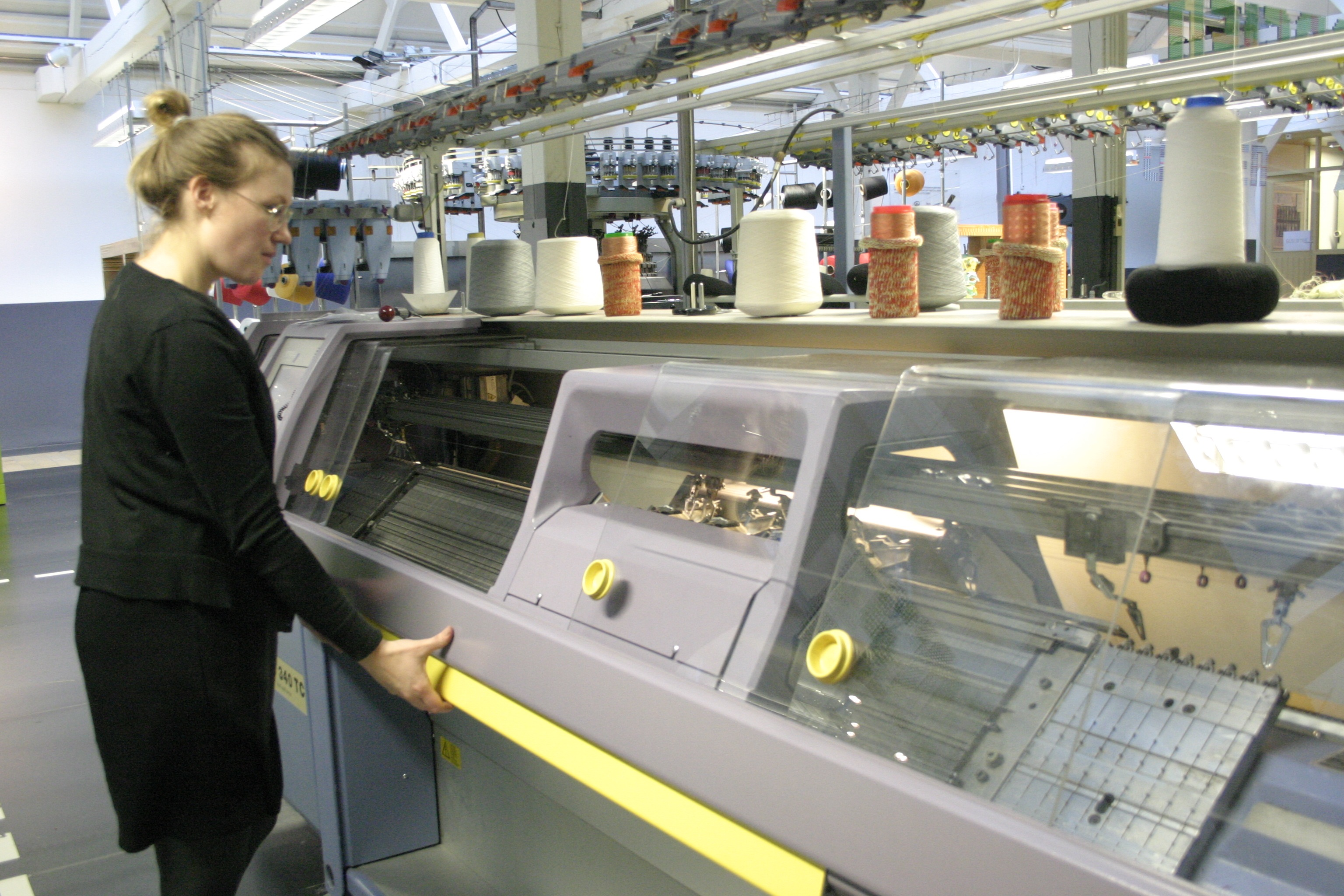Vigour
Issue: XXI.5 September + October 2014Page: 12
Digital Citation
Authors:
Martijn ten Bhömer, Pauline van Dongen
Describe what you made. Vigour is a rehabilitation tool that enables geriatric patients, physiotherapists, doctors, and family to gain more insight into the exercises and progress of a rehabilitation process. A knitted cardigan with integrated stretch sensors monitors the movements of the upper body to give tailored feedback to the patient's movement exercises in real-time by means of sound.
 |
Initial draping of the shape and structure of the garment in Pauline van Dongen's studio. |
Briefly describe the process of how this was made. The prototype was developed in a bottom-up and emergent process in collaboration between TU/e (Ph.D. research of Martijn ten Bhömer), Pauline van Dongen, De Wever, Savo BV, Unit040, Metatronics, and TextielMuseum TextielLab. This work is being carried out as part of the Smart Textile Services project sponsored by the Dutch Ministry of Economic Affairs under the CRISP program.
 |
The knitting program shows the different stitches that form the construction of the textile. |
What for you is the most important/key/interesting thing about what you made? Martijn: The key moment was when one of the patients realized the link between his movements and the sound: He started to wave his arms as if he were conducting an orchestra. Further, I find it intriguing that all the partners in the project are working on the same prototype, but that for each partner the prototype contains different layers of knowledge and meaning.
 |
Jesse Asjes is setting up the Stoll knit and wear machine in the TextielMuseum TextielLab. |
Pauline: The most interesting part is to see how, by knitting conductive yarns, we can reach a true integration of technology with the textile surface. This offers amazing possibilities for the wearability of the design as well as its aesthetics. Such technologically enhanced garments function in an unobtrusive way. It's great to experience the way they support people in their daily lives.
 |
Debugging the Arduino-based electronics (developed by Metronics) with the first sample of the textile. |
What expertise (skills and competences) did it require? Martijn: Unique in this project were the different angles that were required: traditional industrial design and interaction design, electronics engineering, fashion and textile knowledge, and geriatric knowledge. From an interaction design perspective, prototyping was a necessary skill. It functioned both to integrate components together (for example, combining the hard electronics with soft textiles) and as a way to keep partners involved in the process.
 |
The application of Vigour contains a calibration feature to adjust the sensors to the body and posture of the user. |
Pauline: It required insight about the technical abilities of the garment as well as the placement of the sensors, the electrical circuit, and its components. It's very important to design with the specific wearer in mind and consider the way the garment will be used. It required knowledge of knitwear, especially the way you can construct the textile by knitting on different layers with different yarns and incorporating knitted pockets that could contain components. An interdisciplinary project like this requires an open minded, experimental approach and excellent teamwork.
 |
In between production cycles we tested the garment with physiotherapists of eldercare organization De Wever. |
What materials and tools did you use? Martijn: For the integration of textile and electronics we used techniques such as thermal bonding and hand stitching to attach conductive yarns to the soft sensors. Together with Chet Bangaru at TU/e we developed 3D-printed casings tailored for the electronics. We mixed hard and soft materials to improve the wearability.
 |
The sensors are located under the arms and on the lower back. These locations allow the physiotherapists to monitor the most common exercises. |
Pauline: We used a Stoll knitting machine at the TextielLab in Tilburg, where I collaborated with knitwear developer Jesse Asjes. The cardigan is made of high-quality wool combined with sensing areas that are knitted with conductive yarn. The garment is constructed from various panels that are cut and then sewn together.
 |
The electronics are placed in soft 3D-printed casings that follow the shape of the shoulders and back. |
Did anything go wrong? Martijn: Evaluating the placement and sensitivity of the sensors was quite hard. We tested the cardigan and software ourselves, but in the real context the parameters were of course totally different. Further, designing the sound feedback so that it makes sense is still a challenge. In the beginning we used a discrete mapping; for example, three piano sounds for an arm movement. Later we moved to more continuous mappings (volume and pitch).
Pauline: Obviously there's a lot of experimentation going into the development of the knit, first of all, determining the right placement of the sensors, and trying out various types of yarns and stitches as well as textures. After creating the first mock-up it turned out that the sensors weren't working well, so we had to adapt a lot of things, like the way the sleeve is constructed. Later on in the process we also had to change the dimensions of the knitted panels to improve the fit of the cardigan.
As told by Martijn ten Bhömer and Pauline van Dongen, Eindhoven University of Technology
Copyright Held by Authors
The Digital Library is published by the Association for Computing Machinery. Copyright © 2014 ACM, Inc.



